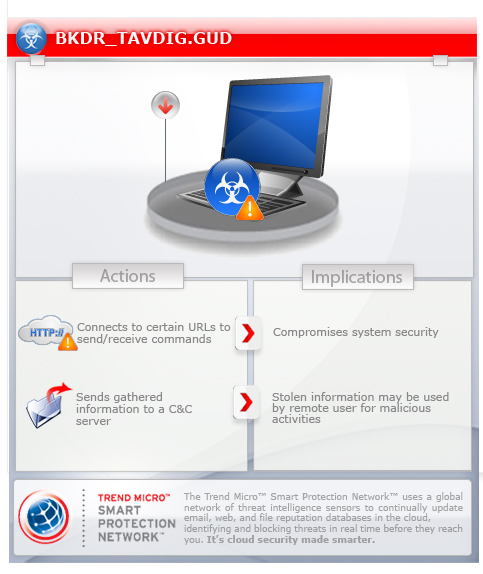BKDR_TAVDIG.GUD
Windows 2000, Windows Server 2003, Windows XP (32-bit, 64-bit), Windows Vista (32-bit, 64-bit), Windows 7 (32-bit, 64-bit)


Threat Type: Backdoor
Destructiveness: No
Encrypted: Yes
In the wild: Yes
OVERVIEW
Dropped by other malware
This malware is the final payload of an attack that utilized a zero-day vulnerability in Windows XP/Server 2003. Users affected by this malware may find the security of their systems compromised.
To get a one-glance comprehensive view of the behavior of this Backdoor, refer to the Threat Diagram shown below.

This backdoor may be dropped by other malware.
It executes commands from a remote malicious user, effectively compromising the affected system.
TECHNICAL DETAILS
176,245 bytes
EXE
Yes
19 Oct 2013
Compromises system security, Collects system information, Connects to URLs/IPs
Arrival Details
This backdoor may be dropped by the following malware:
- TROJ_PIDIEF.GUD
Installation
This backdoor injects codes into the following process(es):
- explorer.exe
- iexplore.exe
- chrome.exe
- firefox.exe
- opera.exe
Autostart Technique
This backdoor adds the following registry entries to enable its automatic execution at every system startup:
HKEY_CURRENT_USER\Software\Microsoft\
Windows NT\CurrentVersion\Winlogon
Shell = "explorer.exe, {Malware Path and filename}.exe"
Backdoor Routine
This backdoor executes the following commands from a remote malicious user:
- Delete files
- Download and execute files
- Send information to C&C
- Terminate itself
It connects to the following URL(s) to send and receive commands from a remote malicious user:
- http://blog.{BLOCKED}splay.com/wp-includes/sitemap/
- http://{BLOCKED}e.ir/wp-content/plugins/online-chat/
It posts the following information to its command and control (C&C) server:
- File listing on certain path including temporary folder
- IPv4 TCP connection table
- IPv4 User Datagram Protocol (UDP) listener table
- Information of running processes
- Installed Windows updates
- Windows information
- Computer name
- Country name
- Current date
- Current directory
- Drive information
- Local group
- Network resource
- Operating system info
- Processor info
- System directory
- System language
- Time zone
- Uptime
- User accounts
- User language
- User name
NOTES:
It does not execute its routine if any of the following network monitoring related process is found:
- tcpdump.exe
- windump.exe
- ethereal.exe
- wireshark.exe
- ettercap.exe
- snoop.exe
- dsniff.exe
SOLUTION
9.700
10.406.05
19 Oct 2013
10.407.00
20 Oct 2013
Step 1
Before doing any scans, Windows XP, Windows Vista, and Windows 7 users must disable System Restore to allow full scanning of their computers.
Step 3
Restart in Safe Mode
Step 4
Delete this registry value
Important: Editing the Windows Registry incorrectly can lead to irreversible system malfunction. Please do this step only if you know how or you can ask assistance from your system administrator. Else, check this Microsoft article first before modifying your computer's registry.
- In HKEY_CURRENT_USER\Software\Microsoft\Windows NT\CurrentVersion\Winlogon
- Shell = "explorer.exe, {Malware Path and filename}.exe"
- Shell = "explorer.exe, {Malware Path and filename}.exe"
Step 5
Restart in normal mode and scan your computer with your Trend Micro product for files detected as BKDR_TAVDIG.GUD . If the detected files have already been cleaned, deleted, or quarantined by your Trend Micro product, no further step is required. You may opt to simply delete the quarantined files. Please check this Knowledge Base page for more information.
Did this description help? Tell us how we did.


